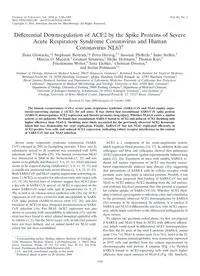
2010 Differential Downregulation of ACE2 by the Spike Proteins of Severe Acute Respiratory Syndrome Coronavirus and Huma PDF
Preview 2010 Differential Downregulation of ACE2 by the Spike Proteins of Severe Acute Respiratory Syndrome Coronavirus and Huma
JOURNAL OF VIROLOGY, Jan. 2010, p. 1198–1205 Vol. 84, No. 2 0022-538X/10/$12.00 doi:10.1128/JVI.01248-09 Copyright © 2010, American Society for Microbiology. All Rights Reserved. Differential Downregulation of ACE2 by the Spike Proteins of Severe Acute Respiratory Syndrome Coronavirus and Human Coronavirus NL63� Ilona Glowacka,1† Stephanie Bertram,1† Petra Herzog,2,3 Susanne Pfefferle,2 Imke Steffen,1 Marcus O. Muench,4 Graham Simmons,4 Heike Hofmann,5 Thomas Kuri,6 Friedemann Weber,6 Jutta Eichler,7 Christian Drosten,8 and Stefan Po¨hlmann1* Institute of Virology, Hannover Medical School, 30625 Hannover, Germany1; Bernhard Nocht Institute for Tropical Medicine, Bernhard-Nocht-Str. 74, 20359 Hamburg, Germany2; Qiagen Hamburg GmbH, Ko¨nigstr. 4a, 22767 Hamburg, Germany3; Blood Systems Research Institute and Department of Laboratory Medicine, University of California, San Francisco, California4; Department of Medical Microbiology and Virology, University of Kiel, 24105 Kiel, Germany5; Department of Virology, University of Freiburg, 79008 Freiburg, Germany6; Department of Medicinal Chemistry, University of Erlangen-Nu¨rnberg, Schuhstrasse 19, 91052 Erlangen, Germany7; and Institute of Virology, University of Bonn Medical Centre, Sigmund-Freud-St. 25, 53127 Bonn, Germany8 Received 16 June 2009/Accepted 16 October 2009 The human coronaviruses (CoVs) severe acute respiratory syndrome (SARS)-CoV and NL63 employ angio- tensin-converting enzyme 2 (ACE2) for cell entry. It was shown that recombinant SARS-CoV spike protein (SARS-S) downregulates ACE2 expression and thereby promotes lung injury. Whether NL63-S exerts a similar activity is yet unknown. We found that recombinant SARS-S bound to ACE2 and induced ACE2 shedding with higher efficiency than NL63-S. Shedding most likely accounted for the previously observed ACE2 downregu- lation but was dispensable for viral replication. Finally, SARS-CoV but not NL63 replicated efficiently in ACE2-positive Vero cells and reduced ACE2 expression, indicating robust receptor interference in the context of SARS-CoV but not NL63 infection. Severe acute respiratory syndrome coronavirus (SARS- CoV) emerged in 2002 in Guangdong province, China, and its subsequent spread to 26 countries was associated with 8,096 infections and 774 deaths (29). The human coronavirus NL63 was discovered in 2004 in the Netherlands (7, 33) and was shown to be globally distributed (2, 3, 6, 23, 31). NL63 infection seems to be acquired during childhood (2, 3, 6, 11, 23, 31) and is usually not associated with severe disease (2, 3, 6, 23, 31–33). Both SARS-CoV and NL63 employ angiotensin-converting en- zyme 2 (ACE2) as receptor for infectious entry into target cells (11, 19, 34). Several lines of evidence suggest that ACE2 plays a key role in SARS-CoV spread: (i) ACE2 is expressed on the major SARS-CoV target cells, type II pneumocytes (4, 9, 25, 30), as well as on ciliated airway epithelial cells (28), (ii) ACE2 expression in cell lines correlates with susceptibility to SARS- CoV spike protein (SARS-S)-driven entry (11, 26), and (iii) knockout of ACE2 in mice abrogates permissiveness to SARS- CoV infection (16). For NL63, ACE2 expression was also shown to correlate with susceptibility to infection (11), and the virus has been found to infect ciliated bronchial epithelial cells in culture (1, 5), but the NL63 target cells in infected patients have not been defined, and an animal model for NL63 repli- cation has not been established. ACE2 is a component of the renin-angiotensin system, which regulates blood pressure (14, 17). In addition, Kuba and colleagues and Imai and colleagues showed that pulmonary ACE2 expression protects against experimentally induced lung injury (13, 16). Treatment of mice with soluble SARS-S re- duced cell surface expression of ACE2 and thereby exacer- bated experimentally induced lung disease (16), suggesting that interactions of SARS-S with its cellular receptor could promote acute lung injury in infected patients. Notably, it has recently been proposed that binding of SARS-CoV but not NL63 to ACE2 induces ACE2 shedding from the cell surface, and evidence has been presented that this process is required for cellular uptake of SARS-CoV (8). Whether ACE2 shed- ding is indeed a prerequisite to infectious entry and contributes to the previously observed ACE2 downregulation by SARS-S (16) remains to be determined. In addition, it is unclear if SARS-S and NL63-S differentially interfere with ACE2 expres- sion, which might contribute to the differential pathogenicity of these viruses. To address the questions raised above, we first investigated if SARS-S and NL63-S bind to ACE2 with different efficien- cies, which could result in differential ACE2 downregulation. For this, the S1 units of the viral S proteins (SARS-S, amino acids 13 to 714; NL63-S, amino acids 16 to 741), fused to the Fc portion of human immunoglobulin, were transiently expressed in 293T cells and purified from the culture supernatants by chromatography with protein A columns (Fig. 1A). Purified SARS-S bound to ACE2-expressing cells with much higher efficiency than equal amounts of NL63-S (Fig. 1B). Similarly, * Corresponding author. Mailing address: Institute of Virology, OE 5230, Hannover Medical School, Carl-Neuberg-Str. 1, 30625 Han- nover, Germany. Phone: 49 511 532 4382. Fax: 49 511 532 8736. E-mail:
